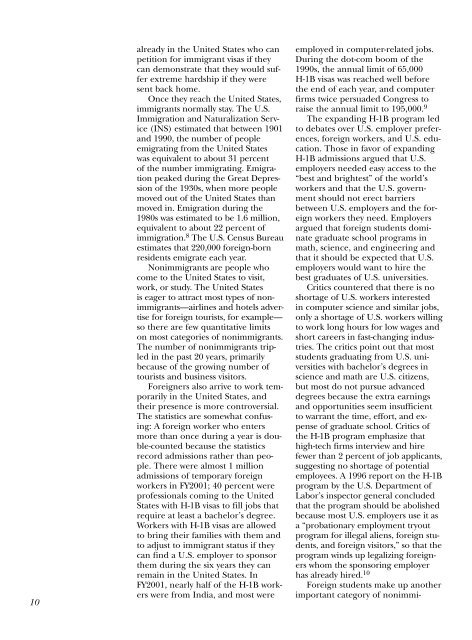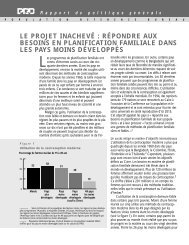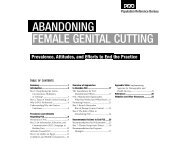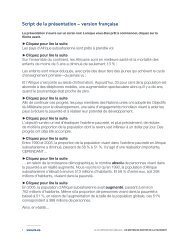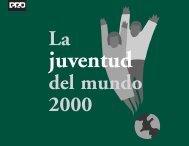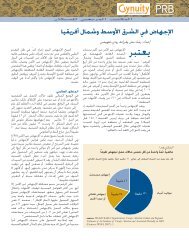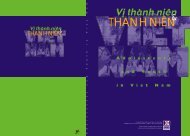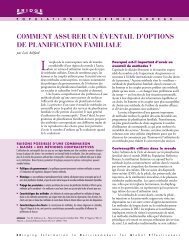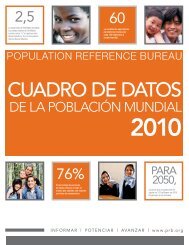Immigration Shaping America - Population Reference Bureau
Immigration Shaping America - Population Reference Bureau
Immigration Shaping America - Population Reference Bureau
You also want an ePaper? Increase the reach of your titles
YUMPU automatically turns print PDFs into web optimized ePapers that Google loves.
10<br />
already in the United States who can<br />
petition for immigrant visas if they<br />
can demonstrate that they would suffer<br />
extreme hardship if they were<br />
sent back home.<br />
Once they reach the United States,<br />
immigrants normally stay. The U.S.<br />
<strong>Immigration</strong> and Naturalization Service<br />
(INS) estimated that between 1901<br />
and 1990, the number of people<br />
emigrating from the United States<br />
was equivalent to about 31 percent<br />
of the number immigrating. Emigration<br />
peaked during the Great Depression<br />
of the 1930s, when more people<br />
moved out of the United States than<br />
moved in. Emigration during the<br />
1980s was estimated to be 1.6 million,<br />
equivalent to about 22 percent of<br />
immigration. 8 The U.S. Census <strong>Bureau</strong><br />
estimates that 220,000 foreign-born<br />
residents emigrate each year.<br />
Nonimmigrants are people who<br />
come to the United States to visit,<br />
work, or study. The United States<br />
is eager to attract most types of nonimmigrants—airlines<br />
and hotels advertise<br />
for foreign tourists, for example—<br />
so there are few quantitative limits<br />
on most categories of nonimmigrants.<br />
The number of nonimmigrants tripled<br />
in the past 20 years, primarily<br />
because of the growing number of<br />
tourists and business visitors.<br />
Foreigners also arrive to work temporarily<br />
in the United States, and<br />
their presence is more controversial.<br />
The statistics are somewhat confusing:<br />
A foreign worker who enters<br />
more than once during a year is double-counted<br />
because the statistics<br />
record admissions rather than people.<br />
There were almost 1 million<br />
admissions of temporary foreign<br />
workers in FY2001; 40 percent were<br />
professionals coming to the United<br />
States with H-1B visas to fill jobs that<br />
require at least a bachelor’s degree.<br />
Workers with H-1B visas are allowed<br />
to bring their families with them and<br />
to adjust to immigrant status if they<br />
can find a U.S. employer to sponsor<br />
them during the six years they can<br />
remain in the United States. In<br />
FY2001, nearly half of the H-1B workers<br />
were from India, and most were<br />
employed in computer-related jobs.<br />
During the dot-com boom of the<br />
1990s, the annual limit of 65,000<br />
H-1B visas was reached well before<br />
the end of each year, and computer<br />
firms twice persuaded Congress to<br />
raise the annual limit to 195,000. 9<br />
The expanding H-1B program led<br />
to debates over U.S. employer preferences,<br />
foreign workers, and U.S. education.<br />
Those in favor of expanding<br />
H-1B admissions argued that U.S.<br />
employers needed easy access to the<br />
“best and brightest” of the world’s<br />
workers and that the U.S. government<br />
should not erect barriers<br />
between U.S. employers and the foreign<br />
workers they need. Employers<br />
argued that foreign students dominate<br />
graduate school programs in<br />
math, science, and engineering and<br />
that it should be expected that U.S.<br />
employers would want to hire the<br />
best graduates of U.S. universities.<br />
Critics countered that there is no<br />
shortage of U.S. workers interested<br />
in computer science and similar jobs,<br />
only a shortage of U.S. workers willing<br />
to work long hours for low wages and<br />
short careers in fast-changing industries.<br />
The critics point out that most<br />
students graduating from U.S. universities<br />
with bachelor’s degrees in<br />
science and math are U.S. citizens,<br />
but most do not pursue advanced<br />
degrees because the extra earnings<br />
and opportunities seem insufficient<br />
to warrant the time, effort, and expense<br />
of graduate school. Critics of<br />
the H-1B program emphasize that<br />
high-tech firms interview and hire<br />
fewer than 2 percent of job applicants,<br />
suggesting no shortage of potential<br />
employees. A 1996 report on the H-1B<br />
program by the U.S. Department of<br />
Labor’s inspector general concluded<br />
that the program should be abolished<br />
because most U.S. employers use it as<br />
a “probationary employment tryout<br />
program for illegal aliens, foreign students,<br />
and foreign visitors,” so that the<br />
program winds up legalizing foreigners<br />
whom the sponsoring employer<br />
has already hired. 10<br />
Foreign students make up another<br />
important category of nonimmi-


